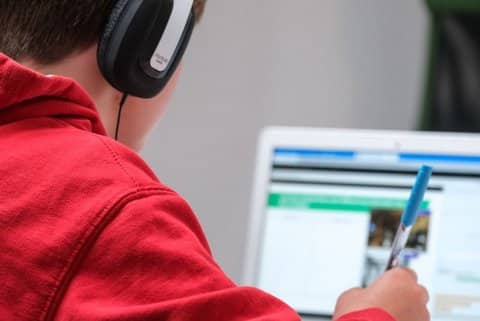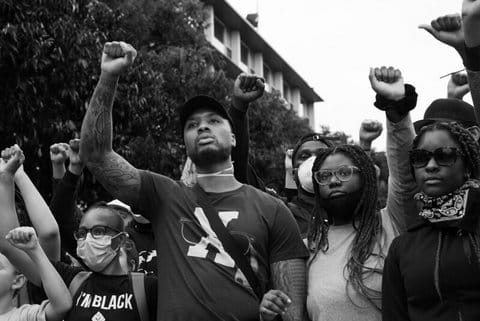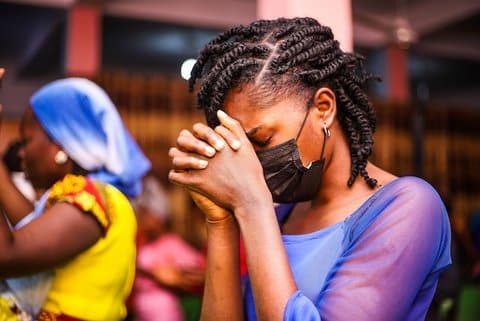
28 Jan Q&A: How Youth Become Radicalized and What to Do

Hate groups often target and prey on boys and young men online, taking advantage of algorithms and their negative feelings and increased time on the internet in an effort to radicalize them. (Photo by Compare Fibre on Unsplash)
Interview, Natasha Kaye
Editor’s note: Experts at the Eradicate Hate Global Summit spoke about how young people — young men, in particular — become radicalized. In part, online hate groups take advantage of algorithms to prey on some young men’s anger and feelings of being left out. We wanted to know more about how this happens and what can be done about it.
The CC Pulse sat down with Erica Barbarossa, the senior research lead at the Center on Terrorism, Extremism and Counterterrorism at the Middlebury Institute of International Studies at Monterey, to discuss how radicalization and extremism have been evolving in online spaces, especially amongst American youth. This conversation has been edited for length and clarity.
The CC Pulse: Where does radicalization and extremism in the United States most commonly begin?
Erica Barbarossa: It’s really hard to indicate where someone may be on the radicalization path line: how close to violence, how close to offline action? What’s the separation between offline action and keyboard warrior vibes? But it seems to be, especially with youth, like the way the human brain works in this idea of ingroup and outgroup: We are humans; animals are not. We are American; that is not the same as Canadian. That’s how our brains function to understand our world.
Where that gets problematic is when the outgroup is viewed as a threat to the in-group. A lot of the talks we have on social media, politics and mainstream society is believing an outgroup, whether that be based on race, gender, orientation and sex, is seen as a threat. That’s when people really start to kind of follow that pipeline into a more radicalized state, because they’re looking for answers on how to get rid of that threat. And that usually has to deal with oppression or violence or some kind of hate speech manifestation.
>>>Read: The Internet Brings Out the Worst in Us
RP: How has the internet and social media shaped this?
EB: [For youth], some say 25 [and under] because your brain is not fully developed. But sometimes when we think of youth, we think of adolescence. In both, we have kids that are very internet-savvy, exist highly online, especially following the pandemic. You no longer need an in-person relationship to adopt these radical views. It’s not just reading a book or your parent or some other person within your community espousing them and you being curious.
So many of our social media platforms are recommendation-algorithm heavy, so it’s going to spit out some nefarious stuff. Every once in a while, that algorithm is going to probably feed you into a darker space if you’re interacting with it. A lot of the times, I think kids don’t really know what they’re seeing. And it’s rare, but there is an uptick in online grooming, a recruitment measure to get into more extremist radicalized spaces. So we’re still seeing stochastic [random] terrorism like, the great replacement and whites getting replaced, and it’s the Jews’ fault, and that’s starting to cycle, and you get your interest piqued, and either the algorithm is leading you that way or you’re curious, and you’re following that pipeline. But now you have more direct engagement on Instagram and gaming platforms. So that’s kind of how some kids are getting involved, like the 12- and 13-year range.
>>>Read: Online Hate ‘Bleeds Into Real Life,’ Promotes School Bullying
RP: Who is doing this grooming?
EB: Some terrorist organizations recruit very young. If you think back to Hitler’s reign, here’s a whole youth division. That’s how you keep the sustainability of the ideology and the group’s belief or the movement belief. So they particularly want to recruit those under 18. Especially because they’re not going to get harsh legal action. And it’s harder, de-radicalization, trying to save an individual, it’s harder to separate those beliefs when it entered your mind at such a young age.
The end goal is typically to start a racial holy war, this big, sparking apocalyptic event, so you can rebuild a white ethno-state on the other side.
RP: Who is most likely to become radicalized in the United States?
EB: What we find time and time again is there’s not a script to it. It’s different for everyone, so you can’t say it’s tied to one specific thing, be it mental health or a specific upbringing or a poverty level, it really can be anyone, and it is anyone. Because what you’re being radicalized into is entirely different, but it does start, across the board, with the idea of grievances, and that’s the driver into radicalization. So within, for instance, neo-fascist spaces, it can be this grievance of a lack of white supremacy, of not knowing where you fit. Viewing outgroups like immigrants, people of color as threatening your role in society.
We see also an uptick in incels and attacks associated with a grievance of a lack of traditional gender roles, of feeling that society is man-hating, boys being unable to find romantic and sexual relations, unable to find marriage, have kids and pursue the ‘American dream.’ As they find these spaces made of other people with shared grievances, they say, ‘Doesn’t this suck?’ ‘Whose fault is it?’ And then ‘What do we do?’ and that’s when you’re fully sucked in.
RP: Which groups are most commonly targeted by online extremism?
EB: It’s usually race-based, especially today. Antisemitism is on the rise across the board everywhere. So that’s probably the main target. Beyond that, I would say it’s predominantly race-based. But we also see a lot of misogyny, growing and a lot of LGBT [people] also being affected.
RP: What are the warning signs of extremism? What should concerned parents and loved ones be aware of?
EB: First is espousing conspiratorial views. So if they’re talking about the ‘great replacement’ or white genocide, that typically is a warning sign that they are in the wrong space online. Instead of parents engaging in a higher surveillance, I think the better approach would probably be having a conversation about that.
The second thing is isolating, especially if you are in contact with an extremist already, or if you’re thinking of taking online rhetoric and offline action. You’re gonna isolate from your community, you’re gonna isolate from your friends, you’re going to kind of hole up because a lot of these are tied to a depressing outlook on life.
The shooter who killed 10 Black Americans in Buffalo two years ago, he believed in the great replacement, and that’s kind of what sparked his radicalization. Reading his manifesto, because we had to do an analysis on it for work, it was a lot of him not wanting to do this attack and not wanting to ‘know the truth’ as he called it. But he was isolating from his family. He was isolated from friends. He stopped going to school, but his parents didn’t know that he had dropped out, and he was 18 when he launched his attack.
The third would be, if you see a rising rhetoric in defending violence and seeing violence as a necessary action. That’s also an early warning sign.
RP: I think about school shooters, and, at least in my mind, there’s a pretty big difference from somebody who’s been disillusioned by something like Qanon and doing some Pizzagate-type of attack believing they’re saving people versus somebody going into their high school and killing their peers. Who are school shooters “avenging”?
EB: That’s a great question. What’s unfortunate for America is that school shootings are very prevalent. The FBI looks into this and tries to study what makes a school shooter and why they do it, and again, there’s no clear-cut answer.
If we’re trying to tie it to extremism, one of the parallels we see is this idea of martyrdom that’s appealing when you’re doing these attacks. So within the terrorist space that we study, accelerationism, there’s this thing called “saints culture.” So if you plan an attack, you kill people in the name of misogyny because you are a male supremacist, or if you kill Jews because you believe they are preying on humanity, or whatever it may be, you’re then canonized as a saint in the community. They make propaganda like a halo above you, and people call themselves the disciples of this person. So there is the idea of wanting to die for something greater and being a part of a movement so that you’re not alone. If you’re a teenager, your whole existence is tied up into some semblance of wanting to belong somewhere and be a part of some community. That could be a big reason why people go this direction. But school shooters are their own thing. It could be based off of vengeance; it could be based off of you wanting infamy. It’s really hard to say.
>>>Q&A: In ‘Accountable,’ Author Tells Story Behind Racist Albany High Instagram Account
RP: What should parents, friends and loved ones do if they see these signs?
EB: There are a lot of campaigns and nongovernmental groups that have resources, know what they’re doing, working with families and making sure it’s done safely. So people don’t feel like ‘Oh, I think my friend is a terrorist,” and then they get arrested. The point is rehabilitation. So they’re very good at that. There’s the Southern Poverty Law Center and PERIL, which is American University’s center. Both made a handout that explains this. And there’s a guide for parents and community on how to spot the signs, what to do, who to reach out to, and stuff like that. So there is a good amount of investment in helping deradicalization
RP: What should people not do?
EB: Ignore it. Whether you’re dealing with people displaying extremism or anything else that plagues society, like suicide ideation, or bullying, don’t do nothing. Get educated, and then try to intervene. It’s a community approach; nothing happens just on an individual level. That’s too much for anyone to take on.
RP: Is there anything we can do to prevent this in the first place?
EB: You can’t cure the disease; you’re just trying to treat it. So that’s kind of what CTEC [the Middlebury Institute Center on Terrorism, Extremism and Counterterrorism]. We work with a lot of social media platforms to educate them on the extremism that exists on their platforms and get it off. We work with them on policy work if things are falling through the cracks. Also, education is huge. We put a lot of pressure on education. It is important to teach critical thinking skills and media literacy so that everyone has the tools when they come across this and what to do. And education in general. We have a grant with the Department of Homeland Security, so we’re building a video game to educate high school students on what to do and how to identify it if you think your friend is experiencing or falling towards extremism.
RP: Any advice for parents going through this?
EB: Parenting is the hardest job in the world, and I think everyone tries their best. Unfortunately, the world is a big, scary place. And I think not every parent has insight into what their kid is doing online, but at the end of the day, if the support is there, just trying to be better in the future, I guess.
This resource is supported in whole or in part by funding provided by the State of California, administered by the California State Library in partnership with the California Department of Social Services and the California Commission on Asian and Pacific Islander American Affairs as part of the Stop the Hate program. To report a hate incident or hate crime and get support, go to CA vs Hate.






No Comments